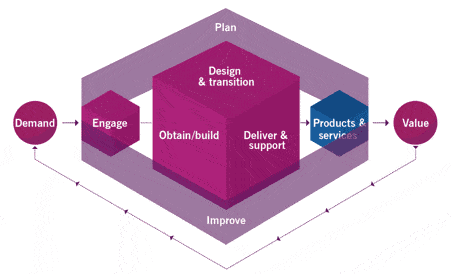The ITIL Service Value Chain
A practical guide for service desk technicians, IT support colleagues, and ITSM specialists
07 mins read
ITIL 4, the latest version of our favorite ITSM best practice framework, has been out since
2019. A new version of ITIL is always big news in the ITSM community, and one of the biggest topics of discussion was around its service value chain. This article will examine the role of the service value chain, how it supports ITIL practices, and how to use it effectively to deliver business outcomes.
The Service Value Chain Explained
So, what is the service value chain (SVC)? The service value chain is an operating model that lists the activities necessary to create value with a product or service. Whereas ITIL v3 focused on the service lifecycle of strategy, design, transition, operation, and continual improvement, ITIL 4 does it differently. The service value chain is a core part of ITIL 4 and facilitates value co-creation. It is the central part of the overall service value system (SVS) and acts as a conduit for actioning service transformation and delivery. It represents how all an organization's components and activities work together to create value.
Service Value Chain Diagram

The service value chain comprises of activities that a company takes in the creation of value:
- Plan - all planning activities. This stage of the service value chain is responsible for creating a shared understanding of the vision, status, and improvement activities for the four dimensions and all products and services.
- Engage - this set of activities looks after all interactions with people, colleagues, end users, customers, management, and partners.
- Design and transition - the analysis and development of new services. This stage looks after all activities to ensure that services and products continually meet stakeholder expectations for cost, quality, and time to market.
- Obtain/Build - this part of the service value chain ensures that service components are available when needed and meet agreed specifications.
- Deliver and support - ensures services are delivered and supported according to agreed specifications and service level agreements (SLAs). This part of the service value chain looks after service delivery and support.
- Improve - ensuring continual improvement of services, products, and practices across all value chain activities and the four dimensions.
Why is the Service Value Chain Needed?
Previous versions of ITIL were quite structured and linear. ITIL v3, for example, represented service delivery as a series of defined steps. First, we had the strategy stage to understand demand and finances and create a plan. Next was the design stage, which made the service blueprint. This was followed by transition, which released the new service to end users, and operations, which dealt with day-to-day support. The final stage was continual service improvement (CSI), which looked at improving service delivery over time. With the
exception of CSI, most people saw the ITIL v3 service lifecycle as quite linear - it assumed that transformation only went one way from strategy to operations and CSI, but no one told the rest of the world that! The real world isn't structured or linear; people change their minds, go back and forth, or introduce new requirements as things change and evolve. In ITIL 4, the service value chain is a way of adapting to this, and by supporting agility and structure, the service value chain enables IT departments to understand better, plan, and manage the activities required to create value through their services, leading to better, faster, safer service delivery and improved customer experience.
Putting theory into practice:
Some example outputs from the service value chain include:
| Service Value Chain Activity | Real Life Output |
Plan |
|
Engage |
|
Design & Transition |
|
Obtain / Build |
|
Deliver & Support |
|
Improve |
|
Real-life example:
| Service Value Chain Activity | Real Life Output |
Plan |
An end-user experiences an issue with a service. |
Engage |
They contact the service desk for help. Depending on the organization, this could be done via phone, email, web chat, artificial intelligence (AI), or self-service. The service desk will engage with that end user and raise an incident. |
Deliver & Support |
The service desk triages the issue, but it cannot be resolved at the first line of contact, so it is escalated to the next tier of support. Further investigation finds that the issue needs a code fix, so the incident is updated with interim support advice and workarounds if available so the service desk can update the end user. |
Engage |
The service desk contacts the end user to provide them with an update and advise on any workarounds, if available. |
Design & Transition |
The support teams involved work to design and transition a code fix, ensuring that it is for purpose and can be safely integrated into the existing service ecosystem. The service desk is advised of an expected release date so the affected user can be aware. |
Engage |
The end user is updated by the service desk so that they know when to expect a permanent resolution. |
Obtain / Build |
The code fix is built and tested at a component level. |
Deliver & Support |
The code is delivered to the live environment, and early life support practices are engaged. |
Engage |
The service desk contacts the end user to confirm everything should be. Once the issue is resolved, the service desk issues a customer satisfaction feedback request. |
Improve |
Feedback from the customer satisfaction request is added to the continual improvement register. |
Plan |
The continual improvement register helps form the plan for future code fixes. |
Service Value Chain Benefits
- Customer centricity. The service value chain prioritizes understanding and meeting stakeholder needs. By leaning into the service value chain, you're committing to aligning services to business requirements and improving customer experience.
- Value delivery. Previous versions of ITIL discussed value, but it always felt a bit nebulous. We'd refer to it in terms of utility and warranty, but what does that mean to the end user?
By using the service value chain, we are putting a structure in place to ensure services are designed, developed, and delivered in a way that maximizes their value and supports the needs of the business. - Improved service delivery. The service value chain streamlines service delivery processes by identifying and optimizing interdependent activities. It removes duplication, minimizes errors, and enhances effectiveness and efficiency.
- More proactive and flexible IT service delivery. The service value chain embeds a culture of continuous improvement within organizations. It encourages regular reviews of services, processes, and performance and ensures that improvement ideas are documented, prioritized, and acted on.
- Alignment with business deliverables. The service value chain ensures that IT services are aligned with the organization's overall business objectives. By linking service delivery to strategic goals, organizations can prioritize assets, resources, and work streams to support business outcomes effectively.
- A more transparent approach to service management. The service value chain provides a
holistic view of the service lifecycle, promoting integration and collaboration across different stages and practices. This leads to improved collaboration, better communication, and better service outcomes.
Final thoughts
The SVC helps IT departments collectively level up service support and delivery offerings. It gives support teams an operating model to plan, design, deliver, support, improve services, and engage with the end-user community. Used effectively, the SVC can drive closer alignment to the business, deliver service outcomes, and strengthen #CX. What's not to love?

